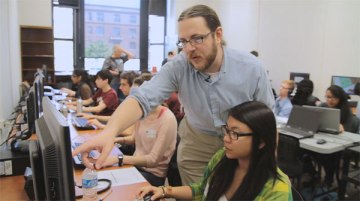A New York City school teacher has crafted a version of Minecraft for schools called MinecraftEdu. Given the sandbox indie game’s simple premise — a pixelated world of blocks that users manipulate with tools — plus the ability to add customizable maps, educators can drop students into a world of ancient cultures, Chemistry, English, and more.
MinecraftEdu creator Joel Levin, who teaches second-grade computer classes at Columbia Grammar and Preparatory School in New York City and runs a Minecraft club for high schoolers, has been incorporating Minecraft into his classes for the past two years.
(MORE: Minecraft – The Top 10 Everything of 2011)
About a year ago, Minecraft (owned by Mojang in Stockholm, Sweden) asked him to build a version for schools so that teachers, regardless of their technical skill, can set up their own server for the game. Levin added an option to turn off the monsters “so the kids wouldn’t have to be worried about getting blown up,” he said. In addition, the original game only allows users to add small bits of text like signs or labels; MinecraftEdu has added text blocks so that teachers can give students more context about whatever world that they have created.

Courtesy of Joel Levin
The game has not been publicly released yet and is still being tested out in schools, but so far MinecraftEdu, through its Finland-based parent company TeacherGaming LLC, has sold Minecraft licenses to more than 500 schools around the world — 100 of them use MinecraftEdu. Levin says that about 250,000 students on six continents have access to Minecraft through his company.
Levin can talk a mile a minute about how the computer game can be applied to every academic discipline. English teachers “give blocks to students and say, ‘Okay, you built a settlement, write the history or write the town charter’,” said Levin.
Eric Walker, a teacher at the American School in Kuwait, has built a “world of humanities” that students can explore to learn about ancient civilizations and geography. (You can get a glimpse of the world here, fast-forward to about 6:55). Foreign language teachers simulate language immersion by asking students to write and speak the language that they are learning whenever they use MinecraftEdu. Here, an Australian science teacher, Stephen Elford, demonstrates a basic Chemistry principle: how particles can turn into a solid, liquid, and gas:
[youtube=http://youtu.be/quDk9osR1Cc]
(You can see more MinecraftEdu videos on the game’s YouTube channel.)
Levin says his students are bringing up Minecraft in classes that do not even use it, and building new skills along the way. “They’re writing poems about Minecraft,” he said. “In my Minecraft club for high schoolers, they’re learning how to program on their own so that they can write their own mods. They’re using their artistic skills to change the graphics. They’re learning about video production so they can make their own Minecraft videos.”
(MORE: The 10 Best Minecraft Mods)
The idea of playing video and computer games in the classroom is not new at all. According to a national survey of 500 teachers who use digital games in the classroom, 32 percent said that they use them 2-4 times a week; 18 percent use them everyday. Seventy percent of these teachers said the games increased students’ motivation and engagement levels. At a speech at TechBoston Academy in March 2011, President Obama announced, “I’m calling for investments in. . . educational software that’s as compelling as the best video game. I want you guys to be stuck on a video game that’s teaching you something other than just blowing something up.”
Levin believes that the way young students navigate the Minecraft world reveals a lot about how they navigate the Internet in general.
“If one kid breaks into another kid’s Minecraft house and steals their stuff, I handle that situation as if it had happened in the real world,” Levin says. “The words that we choose to say to each other in an online environment matter just as much as face to face. For kids growing up in 2012, surrounded by Facebook, it’s very important for tech-savvy grown-ups to give them a model for good conduct and to help them navigate this world that [some] grown-ups don’t understand and are afraid of.”

